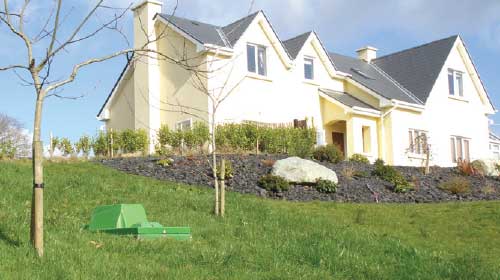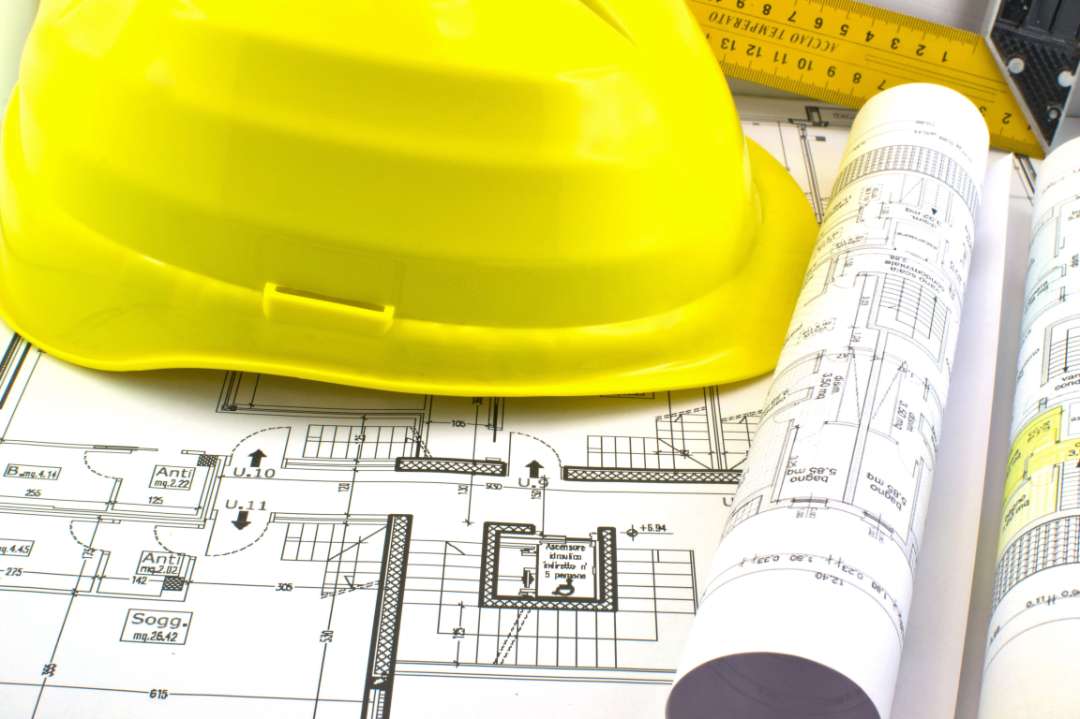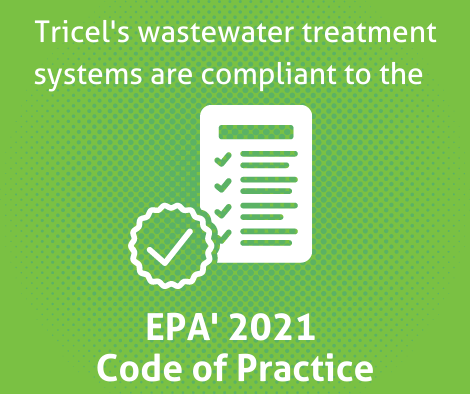
EPA CODE OF PRACTICE 2021
Main changes of the 2021 Code of Practice
Home » Regulation » Code of practice 2021
- May 13, 2024
Table of Contents
The Environmental Protection Agency (EPA) is responsible for protecting and enhancing Ireland’s environment as a vital national asset. Its work is focused across three core areas: regulation, knowledge, and advocacy.
Moreover, as part of its responsibilities, the EPA publishes a Code of Practice for domestic wastewater treatment systems. The most recent version of this document has been in effect since 7 June 2021.
What Does the 2021 Code of Practice Change?
The 2021 Code of Practice provides updated guidance on the design, operation, and installation of domestic wastewater treatment systems for dwellings with a population equivalent (PE) of 10 or fewer. Published under Section 76 of the Environmental Protection Agency Act, 1992, it outlines the standards required for compliance in Ireland.
The revised Code of Practice 2021 introduces a number of important operational and practical updates, including:
New disposal routes for treated wastewater
Additional system options for site-specific challenges
Clearer site assessment criteria
This version applies to all site assessments and installations from 7 June 2021 onwards.
In the following section, we’ll provide an overview of the key changes relevant to Tricel solutions, helping installers and specifiers understand what’s new and how to comply.
The new disposal routes
In order to address certain on-site wastewater treatment issues—which may have serious repercussions on both public health and the environment—the EPA carried out research to identify and evaluate alternative wastewater treatment and disposal options suitable for the Irish context.
As a result of this research, several new disposal routes have been introduced. Below, we outline some of these options and explain how Tricel’s solutions can be adapted to meet the requirements of each.
Disposal route options
Depending on the wastewater treatment solution you require, as well as the type of soil on your site, there are several disposal route options to consider.
In particular, when the soil is located in sensitive areas, such as water table protection zones, both secondary and tertiary wastewater treatment are required. These systems allow for further treatment of the effluent that exits the primary treatment tank.
As a result, they produce a higher quality effluent, with enhanced reduction of pathogens and nutrients. This makes them suitable for environmentally sensitive locations where stricter discharge standards apply.
To better understand how this works in practice, let’s take a look at some specific cases:
Secondary Treatment
Tricel Novo (sewage treatment plant)
The Tricel Novo wastewater treatment plant operates using a Submerged Aerated Filter (SAF) system. In this process, aeration, settlement, and decanting occur within a single reactor, allowing for efficient activation of the sludge treatment cycle.
Furthermore, this Tricel solution is fully compliant with SR 66, I.S. EN 12566 Part 3, and the 2021 Code of Practice (specifically, Section 9 of the document).
If you’d like to explore this in more detail, you can read more about how the Tricel Novo functions.
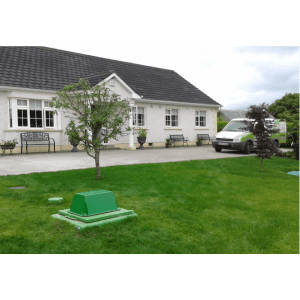
Secondary Treatment
Tricel septic tank + Packaged filter system Puraflo
As the Puraflo is a packaged filter system that uses a bed of coconut fibre to treat wastewater, it qualifies as one of the approved disposal routes under the 2021 Code of Practice (see section 8.2.1 of the document).
Moreover, this wastewater treatment system complies with both SR 66 and I.S. EN 12566 Part 6, ensuring it meets recognised performance and safety standards.
Now, let’s take a closer look at how the Puraflo system works in practice.
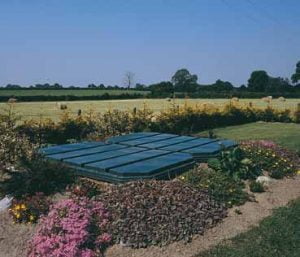
Tertiary Treatment
Tricel Novo (sewage treatment plant) + Tero (Packaged filter system)
or a Sand polishing filter Sandcel
A tertiary treatment system is necessary in cases where a higher quality of effluent is required—particularly when primary and secondary treatment alone are not sufficient. This is especially relevant in situations where reducing nutrients and pathogens is critical, such as in environmentally sensitive areas or near protected water sources.
In addition, the appropriate disposal route is determined by the results of your percolation test, which includes the T-value (subsurface), P-value (surface), and the presence or absence of freely draining subsoil. Based on these findings, different disposal options may be considered suitable to ensure compliance and environmental protection.
For detailed guidance, these disposal options are outlined in Section 10 of the Code of Practice, which explains the role of Tertiary Soil Polishing Filters and how they should be used in conjunction with tertiary treatment systems.
- Tertiary Sand Polishing Filters
- Tertiary Packaged Filters
- Constructed Wetlands Providing Tertiary Treatment
For tertiary treatment with option 6, the free-draining performance required is 0.9m, however, with proven results, this can be reduced to 0.6m.
Tricel has a wastewater treatment solution that can be used with all tertiary treatment options, as mentioned above.

Tricel Novo wastewater treatment plant followed by a Sandcel sand polishing filter
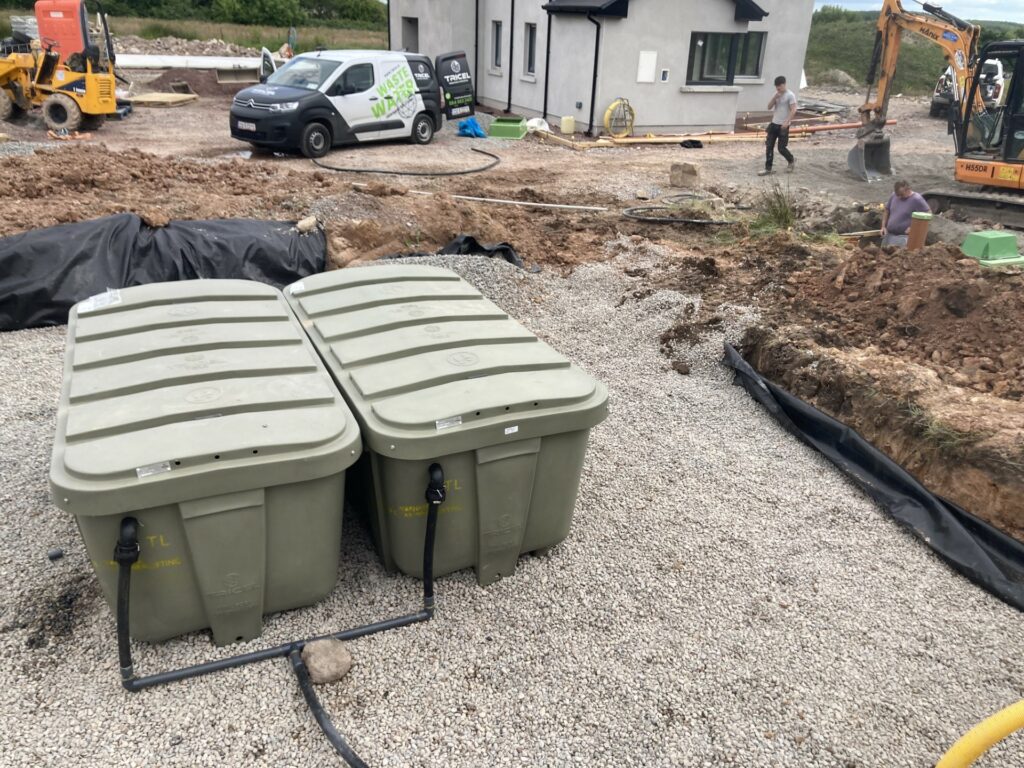
Tricel Novo wastewater treatment plant followed by Tero modules
Code of practice 2021 – New T value range
Firstly, there is a terminology update: what was previously referred to as the ‘T-test’ is now called ‘subsurface’, while the ‘P-test’ is now referred to as ‘surface’.
In addition to the terminology changes, the Code of Practice 2021 introduces a revised range of T Values (Percolation Values) for both infiltration and tertiary treatment.
These values vary depending on the disposal route selected, as outlined below:
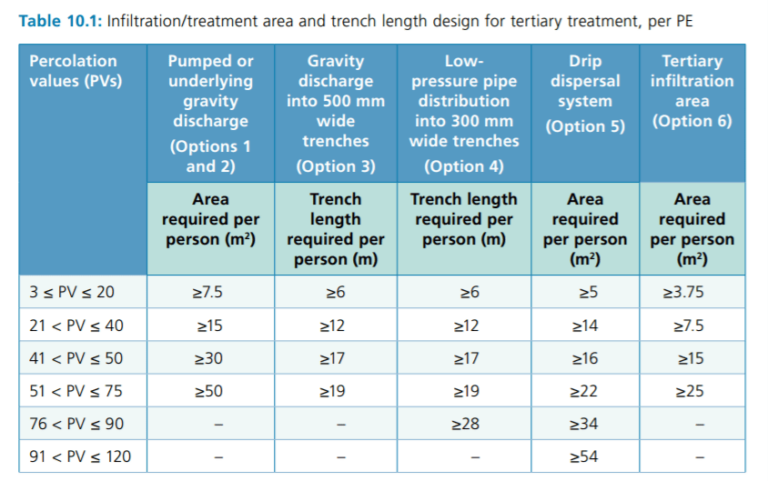
The main changes are:
- Trench length and area required are now designed per population equivalent, which makes it easier to calculate as we just need to multiply up by the number of people within the house
- A bigger disposal area is required from 41 to 50 Percolation Values for gravity discharge – Option 3
- The maximum allowable percolation value for domestic wastewater treatment systems discharging effluent to the ground has increased up to 120: for Low-pressure pipe distribution, option 4, a subsurface value between 3 and 90 can be used, and for Drip dispersal, option 5, a subsurface value between 3 and 120 can be used.
The EPA’s Code of Practice has now provided new loading rates values which make the tertiary infiltration area larger, option 6.
Have a look at all the changes in detail on the EPA’s Code of Practice 2021.
De-sludging recommendation
The lack of regular tank desludging remains a persistent issue in the wastewater industry. In many cases, failing to desludge a septic tank leads to excessive sludge accumulation, which in turn may result in system malfunction or reduced treatment performance.
To address this, the 2021 Code of Practice introduced an important operational update: a recommendation for desludging frequency. Specifically, it provides guidance on how often desludging should take place, based on the tank’s capacity and the number of occupants in the household.
The table provided outlines the suggested desludging rate per annum to help ensure consistent system performance and environmental compliance.
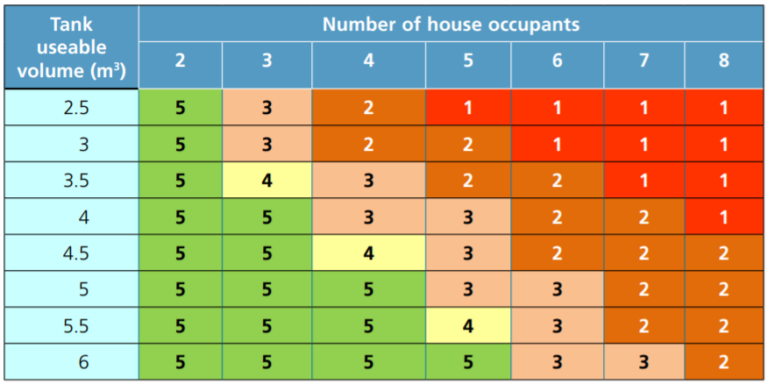
For example: for a 3.5m3 tank for a 3-person house, you may de-sludge your tank every 4 years.
If you do not know the size of the tank, you may use the first row of the table.
When you are de-sludging your septic tank, the pump chamber should also be de-sludged. After de-sludging the chamber, the pump unit should be hosed down, the wash water and sludge should be removed from the pump chamber, and the effluent filter should be cleaned.
You’ll find more information on the EPA’s Code of Practice 2021.
Code of practice 2021 – Site Assessor reports changes
The Code of Practice 2021 also introduces a new chapter to consolidate all the site characterisation criteria regarding planning application and site assessor reports.
Tricel Site Assessor, our free wastewater site recommendation reports tool, includes the requirement of the new Code of Practice to all Site-Specific Reports.
Main changes and additions on Tricel Site Assessor
The main changes are:
- All old references to the CoP 2009 have now been amended to the new 2021 version.
- All sizing references have now been updated (ex: report 2, Package Plant with Gravity Soil Polishing Filter).
- The terminology changes ‘T-value’ to subsurface and ‘P-Value’ to the surface has been updated on our reports.
- Additional disposal routes to added, options 4 and 5.
- Additional third-party treatment options available.
14 reports for wastewater site recommendation are available on this tool.
Choosing a Tricel’s wastewater treatment system
With Tricel you are guaranteed peace of mind through high-quality and certified products. Our range of sewage treatment plants are designed and tested to meet CE regulations and industry standards.
As one of the largest manufacturers of sewage treatment plants in Europe, Tricel is widely recognised by regulators as a benchmark within the industry. Thanks to our extensive experience and strong track record, we are known for setting the standard in reliable and effective wastewater solutions.
Moreover, Tricel provides innovative and trusted solutions that customers can rely on, combining technical excellence with long-term performance.
Therefore, when you choose Tricel, you benefit from a comprehensive package that includes:
Free consultation and expert advice to help assess your needs
High-quality, certified products built for durability and compliance
A network of recognised, highly professional installers for peace of mind
Free commissioning to ensure your system is properly set up
Optional maintenance and service contracts for ongoing support
In short, Tricel delivers reliable wastewater treatment backed by proven support, from initial enquiry to long-term aftercare.
Other articles you might like
50 YEARS IN BUSINESS
A highly successful multinational corporation with over 50 years’ valuable industry experience
SEWAGE TREATMENT PLANTS
Plants available for all capacities, from 1PE up to 50PE. Free advice on request.
Fast Delivery
On-time delivery is a core requirement of our successful business operations
Get in touch
Error: Contact form not found.
